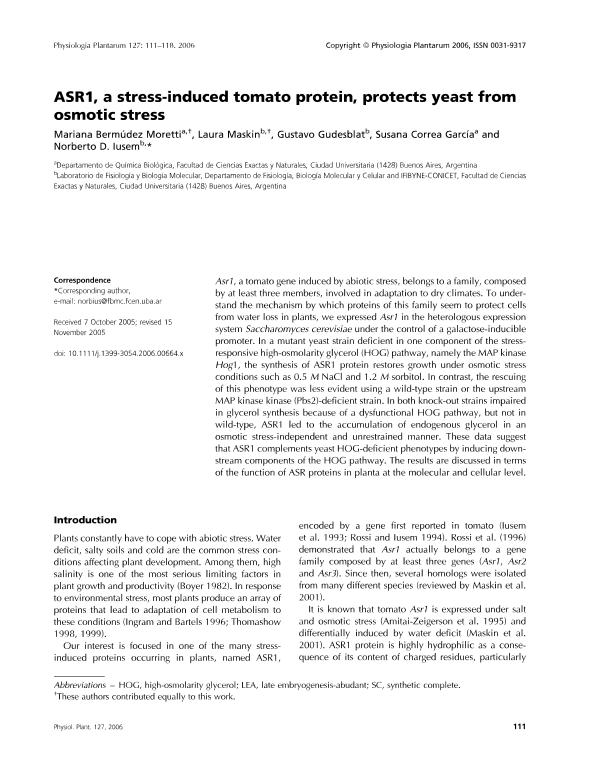Artículo
ASR1, a stress-induced tomato protein, protects yeast from osmotic stress
Bermudez Moretti, Mariana ; Maskin, Laura
; Maskin, Laura ; Gudesblat, Gustavo Eduardo
; Gudesblat, Gustavo Eduardo ; Correa Garcia, Susana Raquel
; Correa Garcia, Susana Raquel ; Iusem, Norberto Daniel
; Iusem, Norberto Daniel
 ; Maskin, Laura
; Maskin, Laura ; Gudesblat, Gustavo Eduardo
; Gudesblat, Gustavo Eduardo ; Correa Garcia, Susana Raquel
; Correa Garcia, Susana Raquel ; Iusem, Norberto Daniel
; Iusem, Norberto Daniel
Fecha de publicación:
05/2006
Editorial:
Wiley Blackwell Publishing, Inc
Revista:
Physiologia Plantarum
ISSN:
0031-9317
Idioma:
Inglés
Tipo de recurso:
Artículo publicado
Clasificación temática:
Resumen
Asr1, a tomato gene induced by abiotic stress, belongs to a family, composed by at least three members, involved in adaptation to dry climates. To understand the mechanism by which proteins of this family seem to protect cells from water loss in plants, we expressed Asr1 in the heterologous expression system Saccharomyces cerevisiae under the control of a galactose-inducible promoter. In a mutant yeast strain deficient in one component of the stress-responsive high-osmolarity glycerol (HOG) pathway, namely the MAP kinase Hog1, the synthesis of ASR1 protein restores growth under osmotic stress conditions such as 0.5 M NaCl and 1.2 M sorbitol. In contrast, the rescuing of this phenotype was less evident using a wild-type strain or the upstream MAP kinase kinase (Pbs2)-deficient strain. In both knock-out strains impaired in glycerol synthesis because of a dysfunctional HOG pathway, but not in wild-type, ASR1 led to the accumulation of endogenous glycerol in an osmotic stress-independent and unrestrained manner. These data suggest that ASR1 complements yeast HOG-deficient phenotypes by inducing downstream components of the HOG pathway. The results are discussed in terms of the function of ASR proteins in planta at the molecular and cellular level.
Palabras clave:
ASR
,
Saccharomyces
,
stress
Archivos asociados
Licencia
Identificadores
Colecciones
Articulos(IFIBYNE)
Articulos de INST.DE FISIOL., BIOL.MOLECULAR Y NEUROCIENCIAS
Articulos de INST.DE FISIOL., BIOL.MOLECULAR Y NEUROCIENCIAS
Articulos(IQUIBICEN)
Articulos de INSTITUTO DE QUIMICA BIOLOGICA DE LA FACULTAD DE CS. EXACTAS Y NATURALES
Articulos de INSTITUTO DE QUIMICA BIOLOGICA DE LA FACULTAD DE CS. EXACTAS Y NATURALES
Citación
Bermudez Moretti, Mariana; Maskin, Laura; Gudesblat, Gustavo Eduardo; Correa Garcia, Susana Raquel; Iusem, Norberto Daniel; ASR1, a stress-induced tomato protein, protects yeast from osmotic stress; Wiley Blackwell Publishing, Inc; Physiologia Plantarum; 127; 1; 5-2006; 111-118
Compartir
Altmétricas



